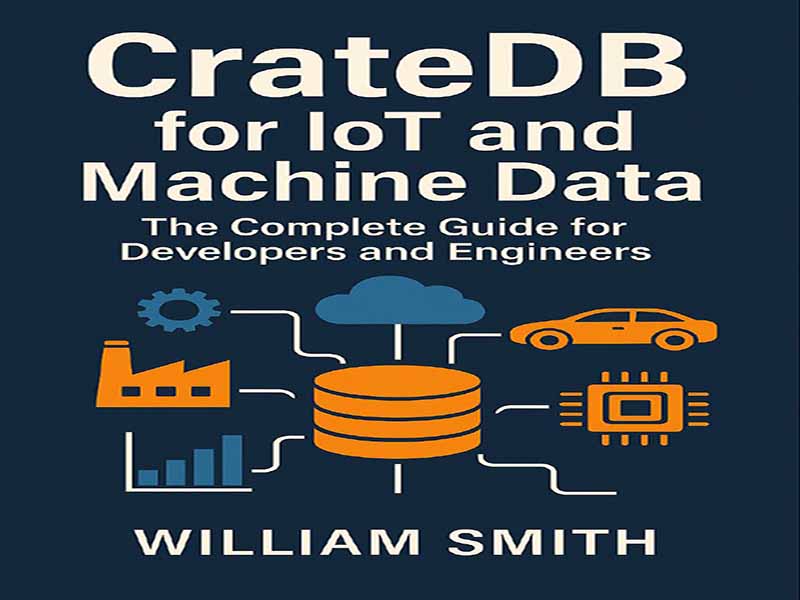- عنوان کتاب: CrateDB for IoT and Machine Data -The Complete Guide for Developers and Engineers
- نویسنده: William Smith
- حوزه: پایگاه داده
- سال انتشار: 2025
- تعداد صفحه: 235
- زبان اصلی: انگلیسی
- نوع فایل: pdf
- حجم فایل: 1.71 مگابایت
گسترش دستگاههای اینترنت اشیا (IoT) و رشد مداوم دادههای تولید شده توسط ماشین، فرصتها و چالشهای بیسابقهای را برای سیستمهای مدیریت داده ایجاد میکند. حجم، سرعت و تنوع دادههای تولید شده توسط این محیطها، نیازمند راهحلهای قوی، مقیاسپذیر و کارآمدی است که برای دادههای سری زمانی و حسگرها بهینه شدهاند. این کتاب، CrateDB برای IoT و دادههای ماشین، به پیچیدگی ذاتی در طراحی، استقرار و بهرهبرداری از یک پلتفرم داده مدرن متناسب با الزامات منحصر به فرد حجم کار دادههای IoT و ماشین میپردازد. در پایه و اساس این متن، درک جامعی از ویژگیهای اصلی دادههای تولید شده توسط IoT وجود دارد. این ویژگیها شامل کاردینالیتی بالای آن، نرخ مصرف سریع، ناهمگونی در انواع دستگاهها و پروتکلها و لزوم ذخیرهسازی قابل اعتماد تحت اتصال متناوب و شرایط شبکه متغیر است. ما با تعریف دقیق این چالشها شروع میکنیم و زمینهای را برای تصمیمگیریهای معماری و انتخاب فناوری فراهم میکنیم. این کتاب با ارائه یک بررسی عمیق از CrateDB، یک پایگاه داده SQL توزیع شده که به طور خاص برای رسیدگی به نیازهای دادههای ماشین در مقیاس بزرگ طراحی شده است، پیش میرود. معماری آن از پردازش پرسوجوی توزیعشده، شاردینگ و یک موتور ذخیرهسازی ستونی ترکیبی برای ارائه عملکرد بالا برای بارهای کاری تراکنشی و تحلیلی بهره میبرد. این امر سازمانها را قادر میسازد تا گردشهای کاری ذخیرهسازی و تحلیلی خود را در یک پلتفرم واحد یکپارچه کنند. مدلسازی طرحوارهای متفکرانه برای مدیریت پیچیدگی و حجم دادههای اینترنت اشیا ضروری است. الگوهای طراحی عملی و استراتژیهای نمایهسازی برای کمک به ثبت جریانهای رویداد متنوع، مدیریت طرحهای داده در حال تکامل و بهینهسازی پرسوجوها تشریح شدهاند. تأکید بر متعادلسازی نرمالسازی برای قابلیت نگهداری و غیرنرمالسازی برای کارایی پرسوجو در زمینه اینترنت اشیا است. دریافت کارآمد دادهها و پردازش جریان، جزء حیاتی هر راهحل اینترنت اشیا را تشکیل میدهند. این کتاب رویکردهای معماری برای ساخت خطوط لوله دریافت انعطافپذیر و با توان عملیاتی بالا، از جمله ادغام با پروتکلهای رایج اینترنت اشیا مانند MQTT و AMQP و همچنین کارگزاران جریان مانند کافکا را بررسی میکند. این کتاب به تضمینهای سازگاری دادهها و مدیریت چرخه عمر، از جمله استراتژیهای پاکسازی و نمونهبرداری کاهشی متناسب با بارهای کاری اینترنت اشیا میپردازد. تکنیکهای پیشرفته پرسوجو، تجزیه و تحلیل و تجسم برای فعال کردن بینشهای عملیاتی در زمان واقعی و تقریباً در زمان واقعی پوشش داده میشوند. مباحث شامل توابع SQL خاص سری زمانی، تجزیه و تحلیل مکانی، قابلیتهای جستجوی متن کامل و ادغام یکپارچه با ابزارهای تجسم محبوب است. علاوه بر این، رویکردهایی برای پیشبینی سری زمانی و تشخیص ناهنجاری با استفاده از یادگیری ماشین ارائه شده است. مقیاسپذیری و بهینهسازی عملکرد به طور کامل مورد بررسی قرار گرفته و استراتژیهای تقسیمبندی و پارتیشنبندی، متعادلسازی بار، کاهش نقاط داغ و مکانیسمهای ذخیرهسازی به تفصیل شرح داده شدهاند. شیوههای نظارت و تشخیص با استفاده از ابزارهایی مانند Prometheus و Grafana، قابلیت مشاهده عملیاتی را در مقیاس فراهم میکنند. این کتاب همچنین مکانیسمهای قابلیت اطمینان و دسترسی بالا ذاتی در CrateDB، از جمله توپولوژیهای تکثیر، failover خودکار، رویههای پشتیبانگیری و بازیابی و برنامهریزی بازیابی فاجعه برای اکوسیستمهای توزیعشده IoT را پوشش میدهد. حفظ یکپارچگی دادهها و مدیریت جریانهای داده بدون طرح یا در حال تکامل به عنوان ملاحظات حیاتی برجسته شدهاند. نگرانیهای امنیتی و انطباق برای پلتفرمهای داده IoT که دادههای حساس دستگاه را مدیریت میکنند، بسیار مهم هستند. متن به تفصیل در مورد مدلهای احراز هویت و مجوز، استانداردهای رمزگذاری، ثبت حسابرسی مطابق با مقررات صنعت و بهترین شیوهها برای ایمنسازی نقاط ورود در برابر تهدیدات نفوذ و انکار سرویس توضیح میدهد. تکنیکهای حفظ حریم خصوصی مانند پوشش دادهها و ناشناسسازی نیز مورد بحث قرار گرفتهاند. برتری عملیاتی از طریق اتوماسیون DevOps و ادغام اکوسیستم افزایش یافته است. این کتاب روشهایی را برای استقرار خودکار با استفاده از ابزارهای تنظیم کانتینر، زیرساخت به عنوان کد و گردشهای کاری ادغام مداوم ارائه میدهد. استراتژیهایی برای پرسوجوی فدرال، معماریهای ترکیبی و الگوهای نوظهور محاسبات لبه و مه برای همگام شدن با چشماندازهای در حال تحول فناوری گنجانده شده است. در نهایت، این کتاب با مطالعات موردی دنیای واقعی و بهترین شیوههای مشتق شده از استقرارهای صنعتی در مقیاس بزرگ به پایان میرسد. این کتاب بینشی در مورد تنظیم تأخیر، قابلیت اطمینان و هزینه و همچنین مسیرهای آینده برای مدیریت دادههای ماشین با CrateDB، از جمله پیشرفتها در تجزیه و تحلیل لبه و تکامل پایگاه داده، ارائه میدهد. این مباحث در کنار هم، منبعی جامع برای مهندسان، معماران و متخصصان داده که به دنبال ساخت و نگهداری پلتفرمهای داده IoT مقیاسپذیر، قابل اعتماد و ایمن هستند، فراهم میکند. بررسی دقیق معماری و اکوسیستم CrateDB، همراه با راهنماییهای عملی در مورد استقرار و بهرهبرداری، خوانندگان را برای مواجهه با چالشهای مدیریت دادههای ماشین مدرن با اطمینان و دقت مجهز میکند.
The proliferation of Internet of Things (IoT) devices and the continuous growth of machine-generated data present unprecedented opportunities and challenges for data management systems. The volume, velocity, and variety of data produced by these environments demand robust, scalable, and efficient solutions optimized for time-series and sensor data. This book, CrateDB for IoT and Machine Data, addresses the complexity inherent in designing, deploying, and operating a modern data platform tailored to the unique requirements of IoT and machine data workloads. At the foundation of this text lies a comprehensive understanding of the core characteristics of IoT-generated data. These include its high cardinality, rapid ingestion rates, heterogeneity across device types and protocols, and the necessity for reliable storage under intermittent connectivity and fluctuating network conditions. We begin by defining these challenges in detail, providing context to inform architectural decisions and technology selection. The book progresses by presenting an in-depth exploration of CrateDB, a distributed SQL database engineered specifically to handle the demands of machine data at scale. Its architecture leverages distributed query processing, sharding, and a hybrid columnar storage engine to deliver high performance for both transactional and analytical workloads. This enables organizations to unify their storage and analytics workflows within a single platform. Thoughtful schema modeling is essential for managing the complexity and volume of IoT data. Practical design patterns and indexing strategies are outlined to assist in capturing diverse event streams, managing evolving data schemas, and optimizing queries. Emphasis is placed on balancing normalization for maintainability and denormalization for query efficiency within the IoT context. Efficient data ingestion and stream processing form a critical component of any IoT solution. The book examines architectural approaches for building resilient, high-throughput ingestion pipelines, including integration with common IoT protocols such as MQTT and AMQP, as well as streaming brokers like Kafka. It addresses data consistency guarantees and lifecycle management, including purging and downsampling strategies tailored to IoT workloads. Advanced querying, analytics, and visualization techniques are covered to enable real-time and near-real-time operational insights. Topics include time-series specific SQL functions, geospatial analytics, full-text search capabilities, and seamless integration with popular visualization tools. Additionally, approaches for time-series forecasting and anomaly detection using machine learning are presented. Scalability and performance optimization are addressed thoroughly, detailing sharding and partitioning strategies, load balancing, hotspot mitigation, and caching mechanisms. Monitoring and diagnostic practices leveraging tools such as Prometheus and Grafana provide operational visibility at scale. The book also covers reliability and high availability mechanisms inherent in CrateDB, including replication topologies, automatic failover, backup and restore procedures, and disaster recovery planning for distributed IoT ecosystems. Maintaining data integrity and managing schemaless or evolving data streams are highlighted as critical considerations. Security and compliance concerns are paramount for IoT data platforms handling sensitive machine data. The text elaborates on authentication and authorization models, encryption standards, audit logging compliant with industry regulations, and best practices for securing ingestion points against intrusion and denial-of-service threats. Privacy-preserving techniques such as data masking and anonymization are also discussed. Operational excellence is enhanced through DevOps automation and ecosystem integration. The book presents methods for automated deployments using container orchestration tools, infrastructure as code, and continuous integration workflows. Strategies for federated querying, hybrid architectures, and emerging edge and fog computing paradigms are included to keep pace with evolving technological landscapes. Finally, the book culminates with real-world case studies and best practices derived from large-scale industrial deployments. It offers insight into tuning for latency, reliability, and cost, as well as future directions for machine data management with CrateDB, including advancements in edge analytics and database evolution. Together, these topics provide a comprehensive resource for engineers, architects, and data professionals seeking to build and maintain scalable, reliable, and secure IoT data platforms. The detailed exploration of CrateDB’s architecture and ecosystem, combined with practical guidance on deployment and operation, equips readers to meet the challenges of modern machine data management with confidence and precision.
این کتاب را میتوانید از لینک زیر بصورت رایگان دانلود کنید:
Download: CrateDB for IoT and Machine Data




































نظرات کاربران